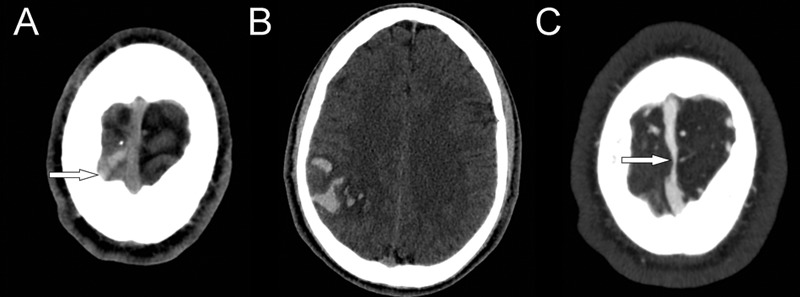Abstract
There are only a few reports of patients developing cerebral venous sinus thrombosis (CVST) after androgen therapy. We present a young man who developed cortical venous thrombosis after using androgens to increase muscle mass. He was hospitalised for parasthesia and dyspraxia in the left hand followed by a generalised tonic–clonic seizure. At admission, he was drowsy, not fully orientated, had sensory inattention, pronation drift and a positive extensor response, all on the left side. The patient had been using anabolic steroids (dainabol 20 mg/day) for the last month for bodybuilding. CT angiography showed a right cortical venous thrombosis. Anticoagulation therapy was started with intravenous heparin for 11 days and oral anticoagulation (warfarin) thereafter. A control CT angiography 4 months later showed resolution of the thrombosis. He recovered fully.
Background
Cerebral venous sinus thrombosis (CVST) can present with a wide spectrum of clinical signs and symptoms, including headache, focal neurological deficits, seizures and coma. There are many causes for CVST but the most common predisposing factors are pregnancy, puerperium, contraceptive pills, coagulopathies and intracranial infections. There are only a few reports of patients developing CVST after androgen therapy.1–3 We present a young man who developed cortical venous thrombosis after using androgens to gain muscle mass. We think it is important to raise awareness about this possibly underdiagnosed cause of stroke, especially in the young.
Case presentation
A 21-year-old previously healthy man was hospitalised because of parasthesia and dyspraxia in the left hand followed by a generalised tonic–clonic seizure. At admission, he was drowsy, not fully orientated, had sensory inattention for the left arm, pronation drift of the left arm and a positive extensor response on the left side. The patient had been using anabolic steroids (dainabol 20 mg/day) for the last 4 months for bodybuilding. He had no signs of an infection. No history of a recent sickness. There was no heredity for thrombosis. He took no medication besides anabolic steroids. He had not undergone any operations or lumbar puncture. There was no recent trauma.
Investigations
A non-contrast CT revealed an intraparenchymal haemorrhage in the right parietal lobe and CT angiography showed a right cortical venous thrombosis with extension to the superior sagittal sinus (figure 1). There were no clinical or radiological signs of otitis, mastoiditis or sinusitis. Complete blood count was normal. Antithrombin, protein C and protein S, factor V Leiden and prothrombin were normal. Antiphospholipid antibodies were negative. Homocystein was normal. C reactive protein and erythrocyte sedimentation were normal. Rheumatological panel was negative.
Figure 1.

(A) Unenhanced axial CT of the uppermost part of the brain shows high attenuation in right cortical vein corresponding to thrombosis. (B) Unenhanced CT of the brain shows an irregular haematoma in right parietal region. (C) CT angiography of the brain shows a filling defect in right part of superior sagittal sinus due to thrombosis in the cortical vein.
Differential diagnosis
Intracerebral haemorrhage of other causes such as hypertension and arteriovenous malformation.
Treatment
Anticoagulation therapy was started with intravenous heparin for 11 days and oral anticoagulation (warfarin) thereafter.
Outcome and follow-up
A control CT angiography 4 months later showed resolution of thrombosis and the patient could stop the anticoagulation treatment. He recovered fully.
Discussion
We found no earlier reports describing isolated cortical venous thrombosis after exogenous androgen use. There is, of course, always difficulty in proving a causal relationship in these cases but our patient had no other risk factors, was healthy and fully recovered after treatment with warfarin for 4 months.
There is some evidence indicating that androgens might promote cerebral thrombosis. First, animals pretreated with androgens have higher death rates, greater clot size and shorter arterial occlusion times than untreated controls in response to thrombotic stimuli.4 These effects could be mediated through platelet aggregation. Androgens potentiate platelet aggregation both in vitro and in vivo through either increased production of thromboxane A2 or decreased production of prostacyclin.5 Second, androgens may also predispose to thrombosis by increasing collagen and other fibrous proteins in arterial vascular tissues and skin.5 Third, danazol (a synthetic testosterone) is used in haemophilia to increase factors VIII and IX.6 As androgen use may be frequent and hidden in athletes, a careful history should be taken in this group of patients.
Learning points.
Cerebral venous sinus thrombosis can present with a wide spectrum of clinical signs and symptoms, including headache, focal neurological deficits, seizures and coma.
Since androgens are frequently used in athletes, all athletes with stroke should be asked about androgen use.
Androgen use might be an underdiagnosed cause of stroke, especially in the young.
Footnotes
Competing interests: None.
Patient consent: Obtained.
Provenance and peer review: Not commissioned; externally peer reviewed.
References
- 1.Jaillard AS, Hommel M, Mallaret M. Venous sinus thrombosis associated with androgens in a healthy young man. Stroke 1994;25:212–13 [DOI] [PubMed] [Google Scholar]
- 2.Frankle MA, Eichberg R, Zachariah S. Anabolic androgenic steroids and a stroke in an athlete: case report. Arch Phys Med Rehabil 1988;69:632–3 [PubMed] [Google Scholar]
- 3.Sahraian MA, Mottamedi M, Azimi AR, et al. Androgen-induced cerebral venous sinus thrombosis in a young body builder: case report. BMC Neurol 2004;4:22. [DOI] [PMC free article] [PubMed] [Google Scholar]
- 4.Uzonava AD. Gonadal hormones and pathogenesis of occlusive arterial thrombosis. Am J Physiol 1978;234:H454–9 [DOI] [PubMed] [Google Scholar]
- 5.Ferenchick GS. Are androgenic steroids thrombogenic? N Engl J Med 1990;322:476. [DOI] [PubMed] [Google Scholar]
- 6.Gralnick HR, Rick ME. Danazol increases factor VIII and factor IX in classic hemophilia and Christmas disease. N Engl J Med 1983;308:1393–5 [DOI] [PubMed] [Google Scholar]


